Steel Slag Sub-Ballast for Sustainable Railway Track Infrastructure
Abstract
1. Introduction
2. Steel Slag Characterization
2.1. Steel Slags
2.2. Experimental Program
2.3. Stress–Strain Behavior
2.4. Resilient and Permanent Deformation Parameters for the Steel Slag
2.4.1. Resilient Modulus Evaluation
2.4.2. Permanent Deformation Evaluation
3. Long-Term Performance of a Ballast Track with Steel Slag
3.1. Calibration of Permanent Deformation Empirical Models
3.2. Numerical Analysis
3.2.1. Numerical Model
3.2.2. Material’s Properties and Loading
3.2.3. Methodology
3.2.4. Discussion of the Results
4. Non-Linear Critical Speed of a Ballast Track with Steel Slag
4.1. Introduction
4.2. Non-Linear Soil Model Calibration
4.3. Non-Linear Numerical Model
5. Conclusions
Author Contributions
Funding
Data Availability Statement
Acknowledgments
Conflicts of Interest
References
- Ramos, A.; Gomes Correia, A.; Indraratna, B.; Ngo, T.; Calçada, R.; Costa, P.A. Mechanistic-Empirical Permanent Deformation Models: Laboratory Testing, Modelling and Ranking. Transp. Geotech. 2020, 23, 1–26. [Google Scholar] [CrossRef]
- Puppala, A.J.; Saride, S.; Chomtid, S. Experimental and Modeling Studies of Permanent Strains of Subgrade Soils. J. Geotech. Geoenviron. Eng. 2009, 135, 1379–1389. [Google Scholar] [CrossRef]
- World Steel Association WSA. Available online: https://worldsteel.org (accessed on 20 July 2023).
- Paixão, A.; Fortunato, E. Abrasion Evolution of Steel Furnace Slag Aggregate for Railway Ballast: 3D Morphology Analysis of Scanned Particles by Close-Range Photogrammetry. Constr. Build. Mater. 2021, 267, 121225. [Google Scholar] [CrossRef]
- Gomes Correia, A.; Roque, A.J.; Reis Ferreira, S.M.; Fortunato, E. Case Study to Promote the Use of Industrial Byproducts: The Relevance of Performance Tests. J. ASTM Int. 2012, 9, 1–18. [Google Scholar] [CrossRef]
- Arribas, I.; Santamaría, A.; Ruiz, E.; Ortega-López, V.; Manso, J.M. Electric Arc Furnace Slag and Its Use in Hydraulic Concrete. Constr. Build. Mater. 2015, 90, 68–79. [Google Scholar] [CrossRef]
- Shi, C. Steel Slag—Its Production, Processing, Characteristics, and Cementitious Properties. J. Mater. Civ. Eng. 2004, 16, 230–236. [Google Scholar] [CrossRef]
- Liu, J.; Xu, J.; Liu, Q.; Wang, S.; Yu, B. Steel Slag for Roadway Construction: A Review of Material Characteristics and Application Mechanisms. J. Mater. Civ. Eng. 2022, 34, 3122001. [Google Scholar] [CrossRef]
- Hussain, A.; Hussaini, S.K.K. Use of Steel Slag as Railway Ballast: A Review. Transp. Geotech. 2022, 35, 100779. [Google Scholar] [CrossRef]
- Alves, R.; Rios, S.; Fortunato, E.; Viana da Fonseca, A.; Guimarães Delgado, B. Mechanical Behaviour of Steel Slag–Rubber Mixtures: Laboratory Assessment. Sustainability 2023, 15, 1563. [Google Scholar] [CrossRef]
- EuroSlag Statistics 2018. Available online: https://www.euroslag.com/research-library-downloads/downloads/ (accessed on 8 August 2023).
- Delgado, B.G.; Viana da Fonseca, A.; Fortunato, E.; Maia, P. Mechanical Behavior of Inert Steel Slag Ballast for Heavy Haul Rail Track: Laboratory Evaluation. Transp. Geotech. 2019, 20, 100243. [Google Scholar] [CrossRef]
- Delgado, B.G.; Viana da Fonseca, A.; Fortunato, E.; Paixão, A.; Alves, R. Geomechanical Assessment of an Inert Steel Slag Aggregate as an Alternative Ballast Material for Heavy Haul Rail Tracks. Constr. Build. Mater. 2021, 279, 122438. [Google Scholar] [CrossRef]
- Jia, W.; Markine, V.L.; Jing, G. Analysis of Furnace Slag in Railway Sub-Ballast Based on Experimental Tests and DEM Simulations. Constr. Build. Mater. 2021, 288, 123114. [Google Scholar] [CrossRef]
- Castro, G.; Saico, J.; de Moura, E.; Motta, R.; Bernucci, L.; Paixão, A.; Fortunato, E.; Oliveira, L. Evaluating Different Track Sub-Ballast Solutions Considering Traffic Loads and Sustainability. Infrastructures 2024, 9, 54. [Google Scholar] [CrossRef]
- Jing, G.; Wang, J.; Wang, H.; Siahkouhi, M. Numerical Investigation of the Behavior of Stone Ballast Mixed by Steel Slag in Ballasted Railway Track. Constr. Build. Mater. 2020, 262, 120015. [Google Scholar] [CrossRef]
- Esmaeili, M.; Askari, A. Laboratory Investigation of the Cyclic Behavior of Rock Ballast Mixed with Slag Ballast for Use in Railway Tracks. Constr. Build. Mater. 2023, 365, 130136. [Google Scholar] [CrossRef]
- Chamling, P.K.; Haldar, S.; Patra, S. Behaviour of Steel Slag Ballast for Railway under Cyclic Loading; Latha Gali, M., P, R.R., Eds.; Springer: Singapore, 2020; pp. 709–722. ISBN 978-981-15-6086-6. [Google Scholar]
- Guo, Y.; Xie, J.; Fan, Z.; Markine, V.; Connolly, D.P.; Jing, G. Railway Ballast Material Selection and Evaluation: A Review. Constr. Build. Mater. 2022, 344, 128218. [Google Scholar] [CrossRef]
- Puppala, A.J.; Mohammad, L.N.; Allen, A. Permanent Deformation Characterization of Subgrade Soils from RLT Test. J. Mater. Civ. Eng. 1999, 11, 274–282. [Google Scholar] [CrossRef]
- Korkiala-Tanttu, L. A New Material Model for Permanent Deformations in Pavements. In Proceedings of the 7th International Conferences on the Bearing Capacity of Roads, Railways and Airfields, Trondheim, Norway, 27–29 June 2005; pp. 1–10. [Google Scholar]
- Rahman, M.S.; Erlingsson, S. Predicting Permanent Deformation Behaviour of Unbound Granular Materials. Int. J. Pavement Eng. 2014, 16, 587–601. [Google Scholar] [CrossRef]
- Mostaqur, R.M.; Gassman, S.L. Permanent Deformation Characteristics of Coarse Grained Subgrade Soils Using Repeated Load Triaxial Tests. Geo-Congress 2019, 2019, 599–609. [Google Scholar]
- Cai, Y.; Sun, Q.; Guo, L.; Juang, C.H.; Wang, J. Permanent Deformation Characteristics of Saturated Sand under Cyclic Loading. Can. Geotech. J. 2015, 52, 795–807. [Google Scholar] [CrossRef]
- Alves Costa, P.; Calçada, R.; Silva Cardoso, A.; Bodare, A. Influence of Soil Non-Linearity on the Dynamic Response of High-Speed Railway Tracks. Soil Dyn. Earthq. Eng. 2010, 30, 221–235. [Google Scholar] [CrossRef]
- Fernández-Ruiz, J.; Castanheira-Pinto, A.; Costa, P.A.; Connolly, D.P. Influence of Non-Linear Soil Properties on Railway Critical Speed. Constr. Build. Mater. 2022, 335, 127485. [Google Scholar] [CrossRef]
- CEN EN 1097-6:2022; Tests for Mechanical and Physical Properties of Aggregates—Part 6: Determination of Particle Density and Water Absorption. European Committee for Standardization: Brussels, Belgium, 2022.
- ASTM D698-12; Standard Test Methods for Laboratory Compaction Characteristics of Soil Using Standard Effort (12,400 Ft-Lbf/Ft3 (600 KN-m/m3)). ASTM Standard: West Conshohocken, PA, USA, 2021. [CrossRef]
- ASTM D1883-21; Standard Test Method for California Bearing Ratio (CBR) of Laboratory-Compacted Soils. ASTM International: West Conshohocken, PA, USA, 2021; pp. 1–14.
- REFER IT.GEO.006-Technical Characteristics of the Sub-Ballast; Technical Instruction. National Railway Network; EPE: Lisbon, Portugal, 2007.
- JGS. Japanese Geotechnical Society (JGS 0520-2009) Preparation of Soil Specimens for Triaxial Tests; Japanese Geotechnical Society: Tokyo, Japan, 2009; pp. 1–10. [Google Scholar]
- Schulz-Poblete, M.V.; Gräbe, P.J.; Jacobsz, S.W. The Influence of Soil Suctions on the Deformation Characteristics of Railway Formation Materials. Transp. Geotech. 2019, 18, 111–123. [Google Scholar] [CrossRef]
- CEN EN 13286-7:2004; Unbound and hydraulically bound mixtures–Part 7: Cyclic load triaxial test for unbound mixtures. European Committee for Standardization: Brussels, Belgium, 2004.
- Maghool, F.; Arulrajah, A.; Suksiripattanapong, C.; Horpibulsuk, S.; Mohajerani, A. Geotechnical Properties of Steel Slag Aggregates: Shear Strength and Stiffness. Soils Found. 2019, 59, 1591–1601. [Google Scholar] [CrossRef]
- Indraratna, B.; Ionescu, D.; Christie, H.D. Shear Behavior of Railway Ballast Based on Large-Scale Triaxial Tests. J. Geotech. Geoenviron. Eng. 1998, 124, 439–449. [Google Scholar] [CrossRef]
- Werkmeister, S.; Dawson, A.R.; Wellner, F. Permanent Deformation Behaviour of Granular Materials. Road Mater. Pavement Des. 2005, 6, 31–51. [Google Scholar] [CrossRef]
- Guo, Y.; Zhai, W. Long-Term Prediction of Track Geometry Degradation in High-Speed Vehicle–Ballastless Track System Due to Differential Subgrade Settlement. Soil Dyn. Earthq. Eng. 2018, 113, 1–11. [Google Scholar] [CrossRef]
- Gidel, G.; Denys, B.; Hornych, P.; Chauvin, J.-J.; Denis, A. A New Approach for Investigating the Permanent Deformation Behavior of Unbound Granular Material Using the Repeated Load Triaxial Apparatus. Bull. Lab. Ponts Chaussées 2001. [Google Scholar]
- Chen, R.; Chen, J.; Zhao, X.; Bian, X.; Chen, Y. Cumulative Settlement of Track Subgrade in High-Speed Railway under Varying Water Levels. Int. J. Rail Transp. 2014, 2, 205–220. [Google Scholar] [CrossRef]
- Ramos, A.; Gomes Correia, A.; Calçada, R.; Alves Costa, P.; Esen, A.; Woodward, P.K.; Connolly, D.P.; Laghrouche, O. Influence of Track Foundation on the Performance of Ballast and Concrete Slab Tracks under Cyclic Loading: Physical Modelling and Numerical Model Calibration. Constr. Build. Mater. 2021, 277, 122245. [Google Scholar] [CrossRef]
- Mathworks Least-Squares (Model Fitting) Algorithms [Online]. Available online: https://www.mathworks.com/help/optim/ug/least-squares-model-fitting-algorithms.html (accessed on 8 August 2023).
- Marolt Čebašek, T.; Esen, A.F.; Woodward, P.K.; Laghrouche, O.; Connolly, D.P. Full Scale Laboratory Testing of Ballast and Concrete Slab Tracks under Phased Cyclic Loading. Transp. Geotech. 2018, 17, 33–40. [Google Scholar] [CrossRef]
- UIC—International Union of Railways. UIC—International Union of Railways. UIC Code 719R: Earthworks and Track Bed for Railway Lines. In UIC 719 R Earthworks Track Bed Railway Lines; UIC: Paris, France, 2008; p. 117. [Google Scholar]
- Biarez, J.; Liu, H.; Gomes Correia, A.; Taibi, S. Stress-Strain Characteristics of Soils Interesting the Serviceability of Geotechnical Structures. In Proceedings of the Pre-Failure Deformation Characteristics of Geomaterials, Torino, Italy, 28–30 September 1999; pp. 617–624. [Google Scholar]
- Gomes Correia, A.; Cunha, J. Analysis of Nonlinear Soil Modelling in the Subgrade and Rail Track Responses under HST. Transp. Geotech. 2014, 1, 147–156. [Google Scholar] [CrossRef]
- Dong, K.; Connolly, D.P.; Laghrouche, O.; Woodward, P.K.; Alves Costa, P. Non-Linear Soil Behaviour on High Speed Rail Lines. Comput. Geotech. 2019, 112, 302–318. [Google Scholar] [CrossRef]
- Ishibashi, I.; Zhang, X. Unified Dynamic Shear Moduli and Damping Ratios of Sand and Clay. Soils Found. 1993, 33, 182–191. [Google Scholar] [CrossRef]
- Bolton, M.D. The Strength and Dilatancy of Sands. Geotechnique 1986, 36, 65–78. [Google Scholar] [CrossRef]
- Galavi, V.; Brinkgreve, R.B.J. Finite Element Modelling of Geotechnical Structures Subjected to Moving Loads. Numer. Methods Geotech. Eng. 2014, 235–240. [Google Scholar]
- Costa, P.A.; Colaço, A.; Calçada, R.; Cardoso, A.S. Critical Speed of Railway Tracks. Detailed and Simplified Approaches. Transp. Geotech. 2015, 2, 30–46. [Google Scholar] [CrossRef]

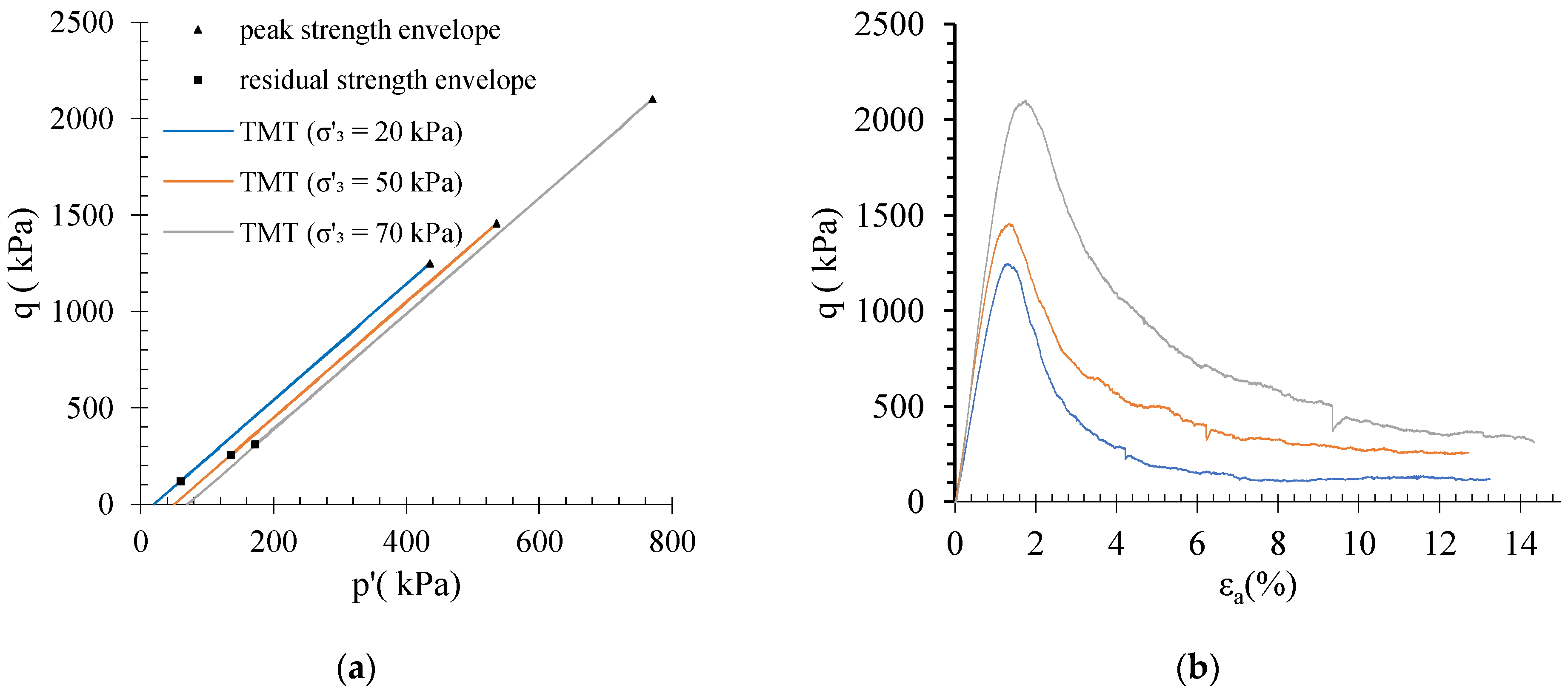


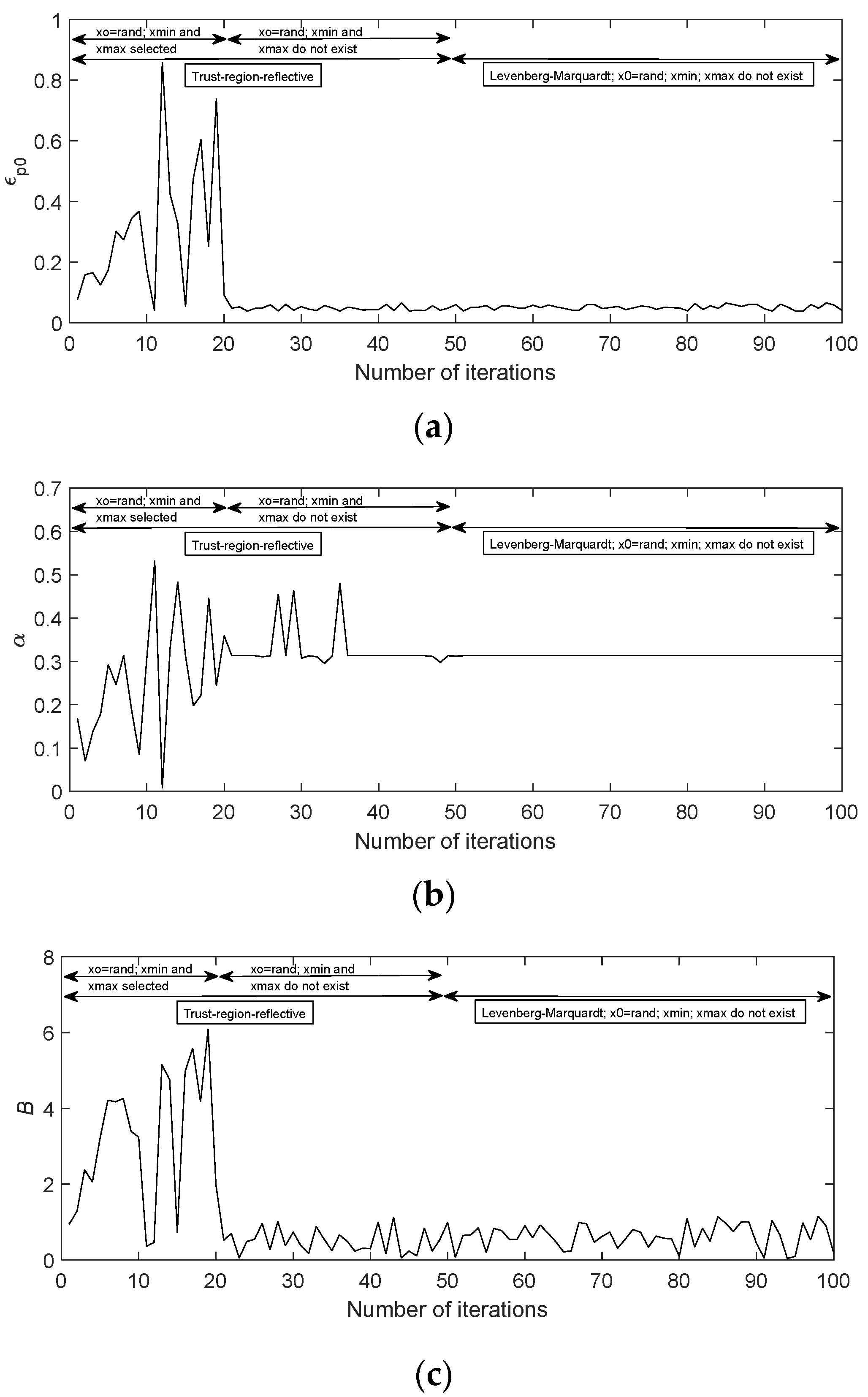





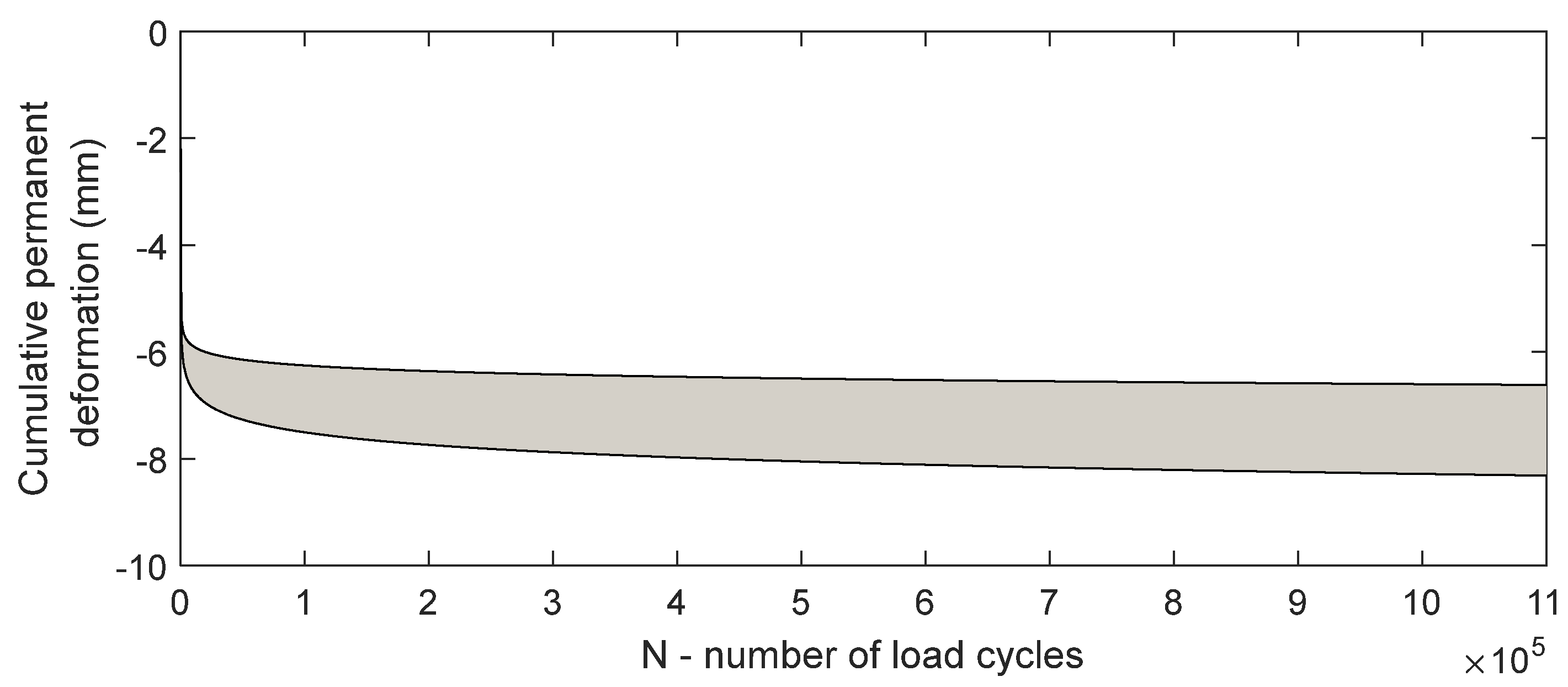
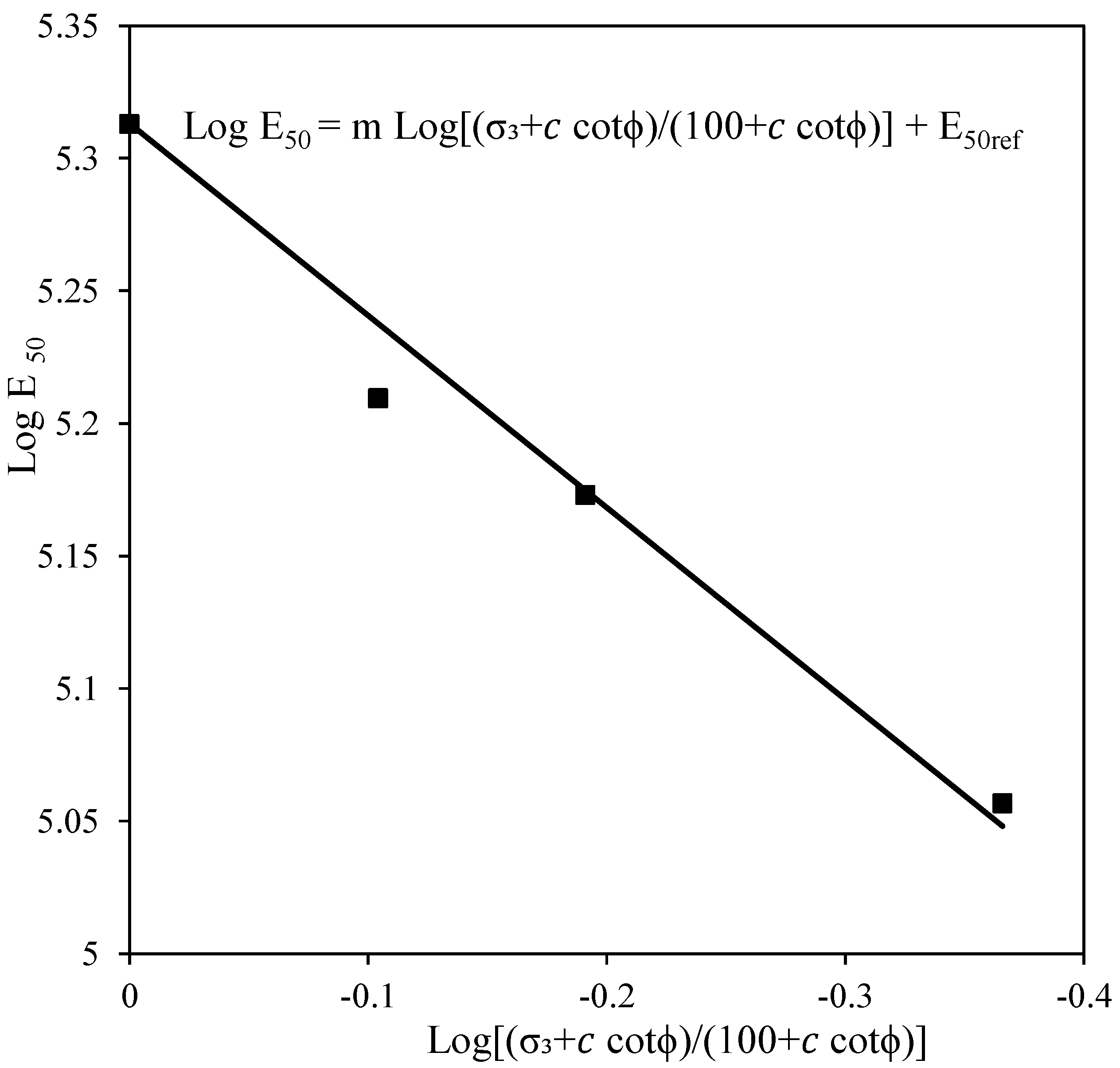
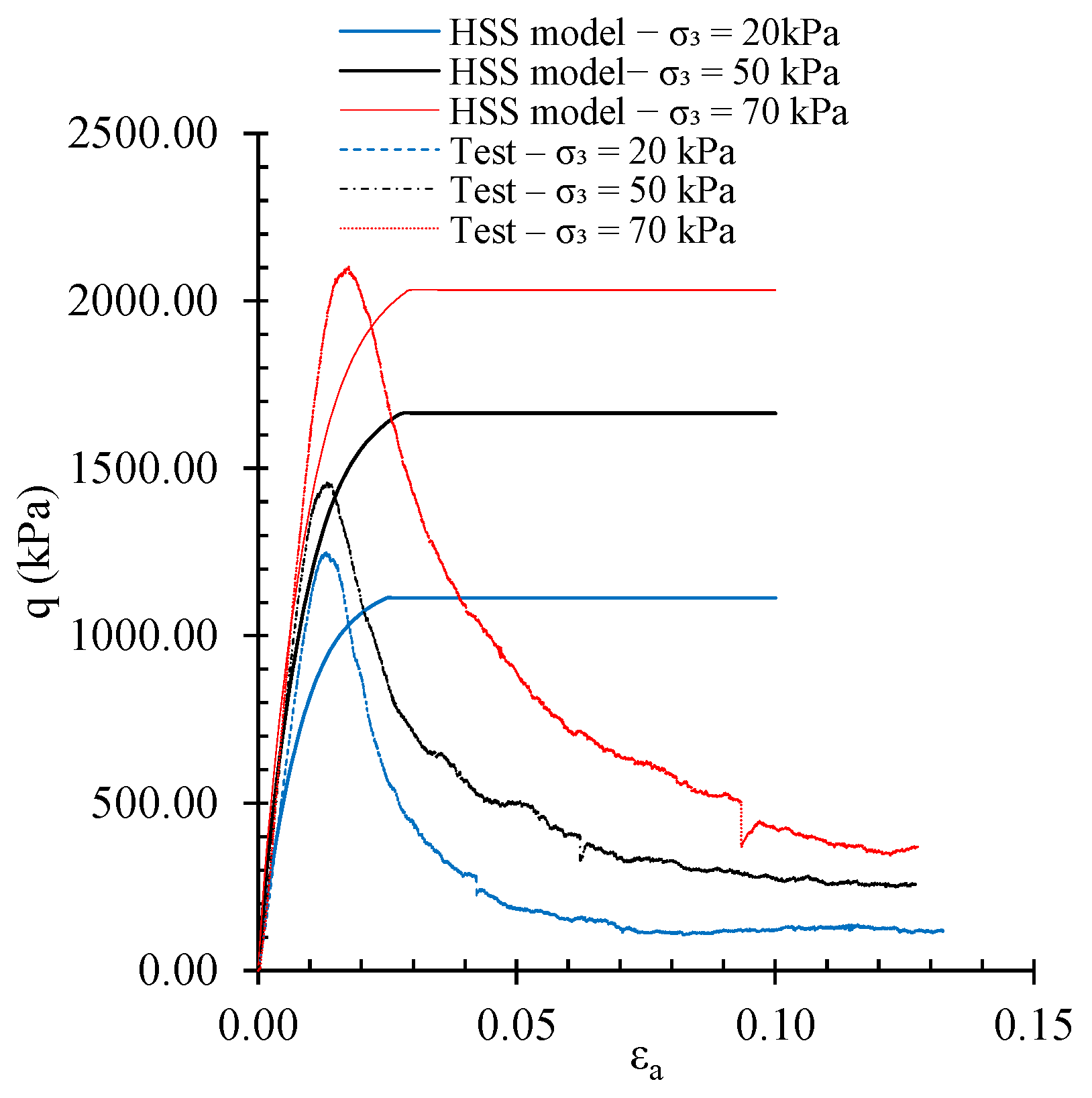
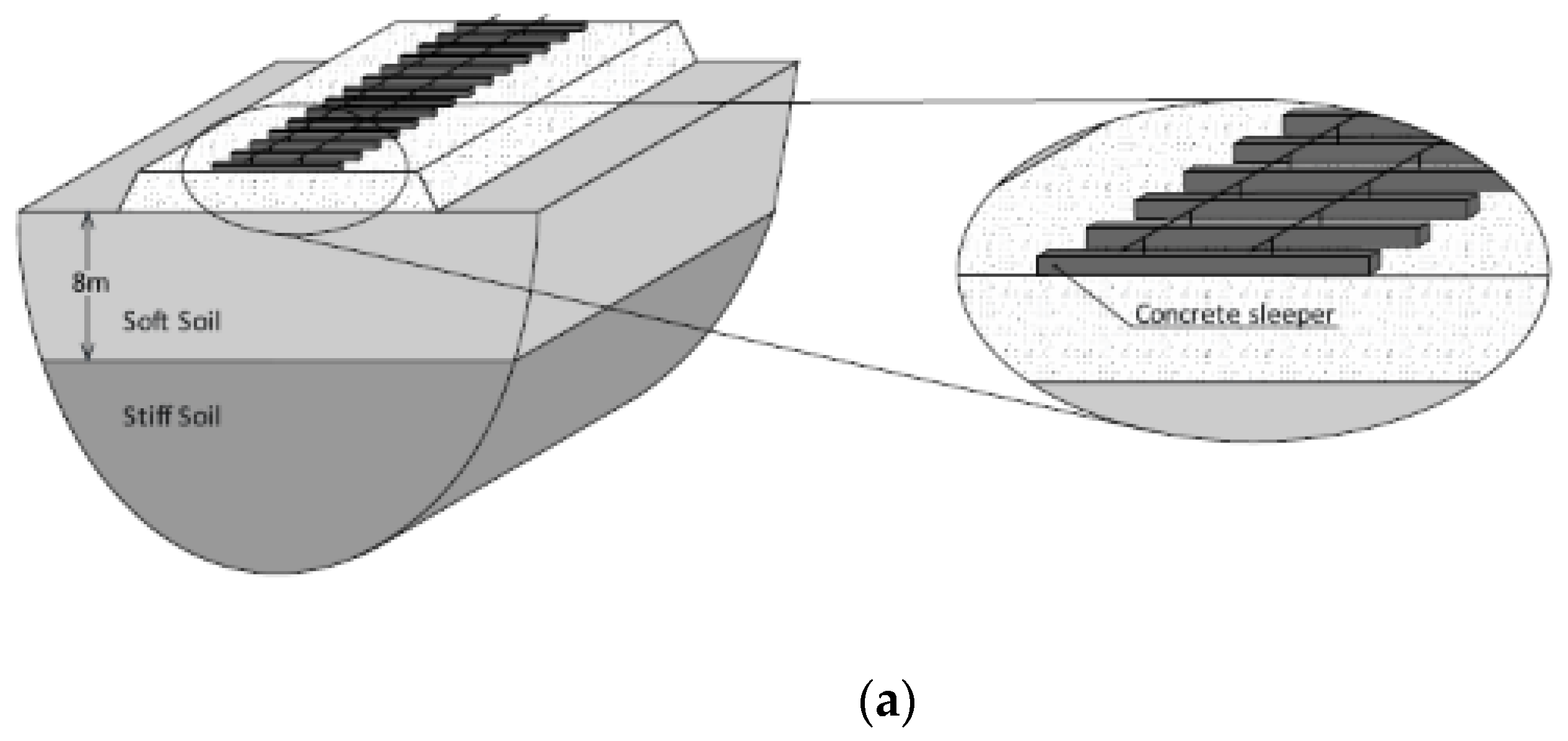

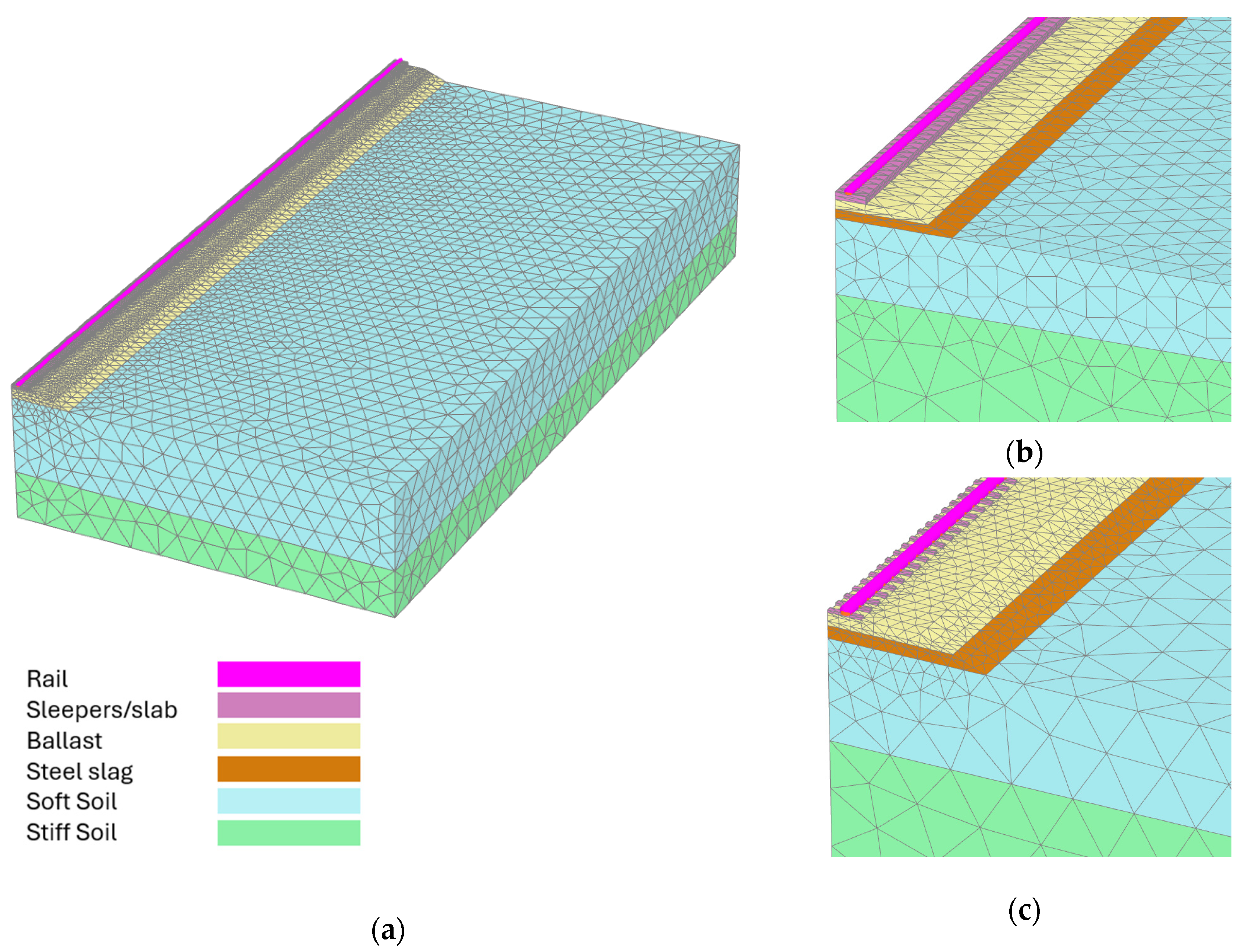


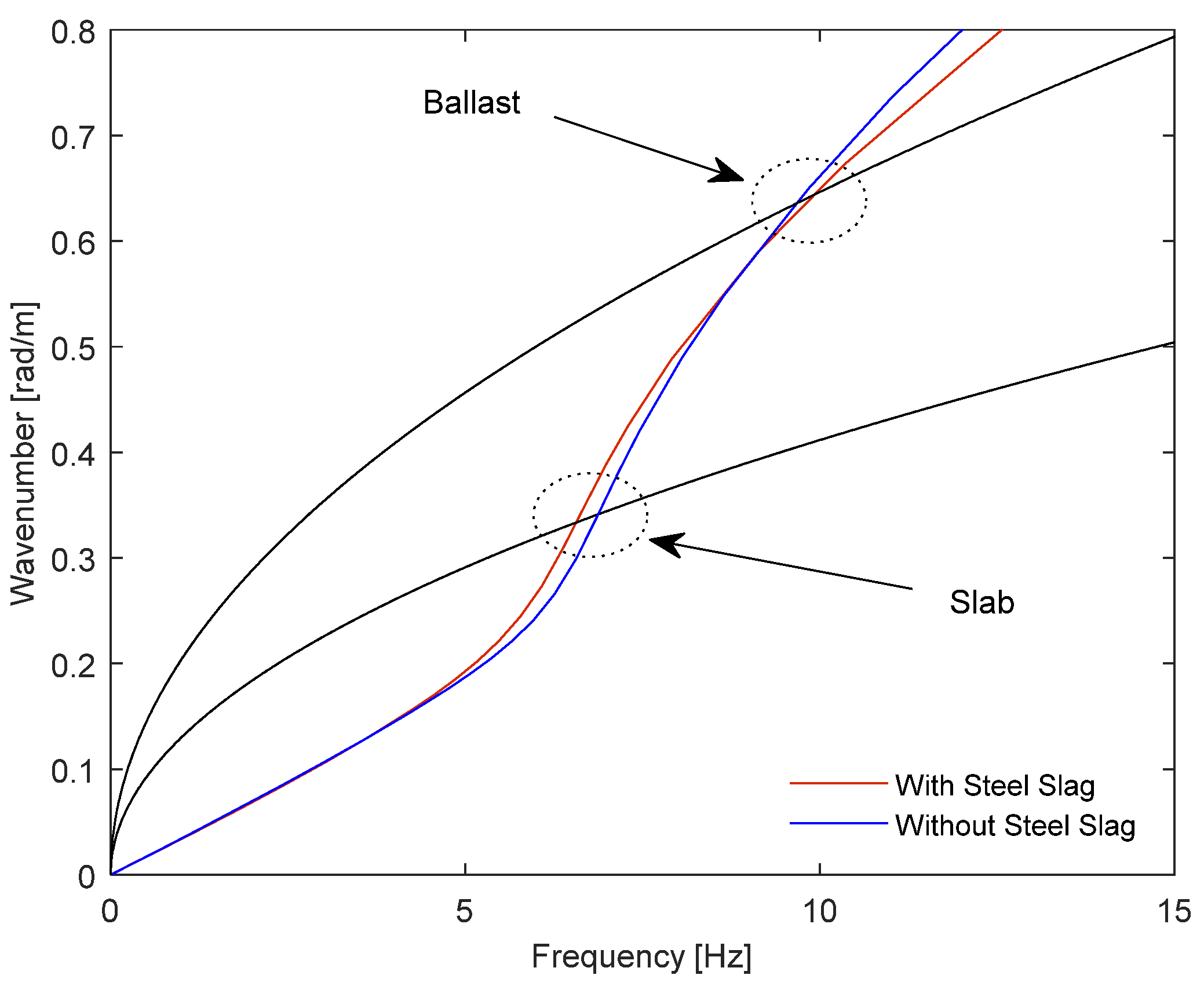
| Parameters | Values |
|---|---|
| D50 | 5 mm |
| Fines content (<0.074 mm) | 8% |
| Uniformity Coefficient | 100 |
| Curvature Coefficient | 2.25 |
| Specific gravity | 3.53 |
| Maximum dry unit weight | 2850 kg/m3 |
| Optimum moisture content | 4% |
| CBR | 213% |
| Resilient Modulus Tests | Permanent Deformation Tests | ||||
|---|---|---|---|---|---|
| (kPa) | qmax | Nº cycles | (kPa) | qmax | NO. Cycles |
| 70 | 4.86 | 20,000 | 20 | 2.5 | 1,000,000 |
| 20 | 1.50; 2.50; 4.00; 5.75 | 100/load stage | |||
| 35 | 1.43; 2.29; 3.29; 4.29; 5.71 | 100/load stage | |||
| 50 | 1.60; 2.30; 3.00; 4.00; 5.60 | 100/load stage | |||
| 70 | 1.64; 2.14; 2.86; 4.00; 4.86 | 100/load stage | |||
| 100 | 1.50; 2.00; 2.80; 3.40; 4.00 | 100/load stage | |||
| 150 | 1.33; 1.87; 2.27; 2.67; 3.17 | 100/load stage | |||
| Parameters | Values |
|---|---|
| εp0 | 0.052 |
| B | 0.313 |
| α | 0.668 |
| Material | Properties | Observations |
|---|---|---|
| Rail (BS113A) | E = 200 × 109 Pa ρ = 7850 kg/m3 ν = 0.30 | BS113A (56 × 101) |
| EPDM/Railpad | k = 40 × 106 N/m ρ = 1200 kg/m3 ν = 0.00 thickness/area Area = 0.140 × 0.133 [m2] Thickness = 10 × 10−3 m | [42] |
| Sleepers (G44–650mm spacing) | E = 38 × 109 Pa ρ = 2500 kg/m3 ν = 0.15 | Sleeper G44 |
| Ballast | E = 110 × 106 Pa ρ = 1530 kg/m3 ν = 0.30 | [43] |
| Subgrade | E = 3.3 × EV2 = 3.3 × 65 × 106 Pa ρ = 2091 kg/m3 ν = 0.35 | E is based on Ev2 [42] |
| Sub-ballast–steel slag | E = 171 × 106 Pa; ρ = 2960 kg/m3 Ν = 0.20 | Values were based on the laboratory tests described in Section 2. |
| Type of Track | Material | Parameters | Strength Parameters | |||
|---|---|---|---|---|---|---|
| εp0 | B | α | c′ (kPa) | ϕ′ | ||
| Ballasted track | Ballast | 0.014 | 1.512 | 0.995 | 0 | 50° |
| Steel slag | 0.038–0.85 | 0.04–6.00 | 0.007–0.53 | 85 | 64° | |
| Subgrade | 0.119 | 0.004 | 0.943 | 5 | 35° | |
| Parameter | Value |
|---|---|
| (MPa) | 206 |
| (MPa) | 206 |
| (MPa) | 696 |
| m | 0.7 |
| υ | 0.2 |
| 0.25 | |
| (MPa) | 498 |
| 8.09 × 10−4 | |
| c′ (kPa) | 85 |
| (°) | 64 |
| (°) | 24 |
| Layer | Young Modulus | Density | Poisson Ratio | Damping Coefficient | Shear Wave Velocity |
|---|---|---|---|---|---|
| E (MPa) | ρ (kg/m3) | ν (-) | ξ (-) | Cs (m/s) | |
| Slab/Sleeper | 25e3 | 2500 | 0.20 | 0.01 | 2236 |
| Embankment (ballast and sub-ballast) | 200 | 2000 | 0.30 | 0.03 | 196 |
| Soft soil | 30.5 | 1600 | 0.35 | 0.03 | 80 |
| Steel slag | 1123 | 2800 | 0.2 | 0.03 | 409 |
| Stiff soil | 208 | 2000 | 0.30 | 0.03 | 200 |
| Rail (UIC 60) | 210e3 | 7850 | 0.30 | 0.01 | 5170 |
| Rail pads | Kpad = 50 kN/mm and 0.6m of longitudinal spacing. | ||||
| Element | E50 (kPa) | Eoed (kPa) | Eur (kPa) | ϕ′ (º) | c′ (kPa) | Ψ (º) | γ0.7 |
|---|---|---|---|---|---|---|---|
| Embankment (ballast and sub-ballast) (PI 0) | 35 × 103 | 35 × 103 | 70 × 103 | 45 | 5 | 10 | 7.5 × 10−5 |
| Soft soil (PI 50) | 1.3 × 103 | 1.3 × 103 | 4 × 103 | 0 | 50 | 0 | 9.7 × 10−4 |
| Soft soil (PI 15) | 1.3 × 103 | 1.3 × 103 | 4 × 103 | 0 | 50 | 0 | 3.6 × 10−4 |
| Stiff soil (PI 0) | 40 × 103 | 40 × 103 | 80 × 103 | 35 | 5 | 10 | 2.4 × 10−4 |
| Steel slag | 205 × 103 | 40 × 103 | 696 × 103 | 64.41 | 84.56 | 24.26 | 8.1 × 10−4 |
Disclaimer/Publisher’s Note: The statements, opinions and data contained in all publications are solely those of the individual author(s) and contributor(s) and not of MDPI and/or the editor(s). MDPI and/or the editor(s) disclaim responsibility for any injury to people or property resulting from any ideas, methods, instructions or products referred to in the content. |
© 2024 by the authors. Licensee MDPI, Basel, Switzerland. This article is an open access article distributed under the terms and conditions of the Creative Commons Attribution (CC BY) license (https://creativecommons.org/licenses/by/4.0/).
Share and Cite
Alves, R.; Ramos, A.; Castanheira-Pinto, A.; Rios, S.; Fernández-Ruiz, J. Steel Slag Sub-Ballast for Sustainable Railway Track Infrastructure. Infrastructures 2024, 9, 106. https://doi.org/10.3390/infrastructures9070106
Alves R, Ramos A, Castanheira-Pinto A, Rios S, Fernández-Ruiz J. Steel Slag Sub-Ballast for Sustainable Railway Track Infrastructure. Infrastructures. 2024; 9(7):106. https://doi.org/10.3390/infrastructures9070106
Chicago/Turabian StyleAlves, Rubens, Ana Ramos, Alexandre Castanheira-Pinto, Sara Rios, and Jesús Fernández-Ruiz. 2024. "Steel Slag Sub-Ballast for Sustainable Railway Track Infrastructure" Infrastructures 9, no. 7: 106. https://doi.org/10.3390/infrastructures9070106
APA StyleAlves, R., Ramos, A., Castanheira-Pinto, A., Rios, S., & Fernández-Ruiz, J. (2024). Steel Slag Sub-Ballast for Sustainable Railway Track Infrastructure. Infrastructures, 9(7), 106. https://doi.org/10.3390/infrastructures9070106







